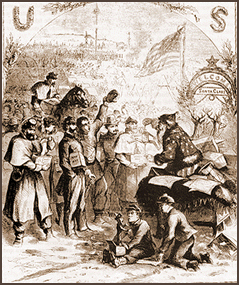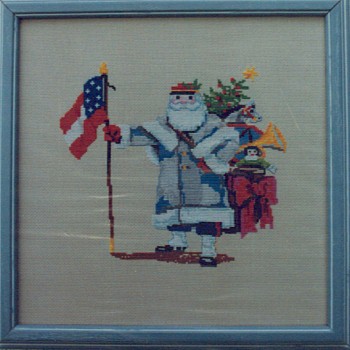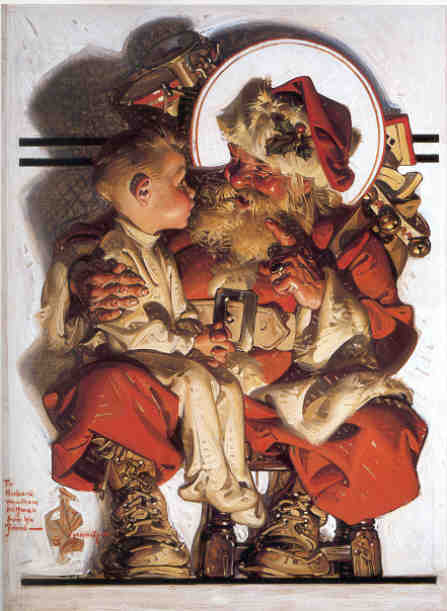
Historical evidence shows that St. Nicholas never existed as a mere mortal, as he is often believed to have been. He was rather a Christianized version of various Pagan sea Gods, the Greek God Poseidon, the Roman God Neptune, and the Celtic Winter God The Holly King. In the early centuries of the Christian church, many Pagan Gods and Goddesses were converted into Christian saints. When the church created the persona of St. Nicholas, they adopted Poseidon's title "the Sailor." Then they simply took his last name from Nickar. Many temples of Poseidon became shrines of St. Nicholas. St. Nicholas also adopted some of the qualities of "The Grandmother" or Befana from Italy. She was said to have filled children's stockings with gifts. Her shrine at Bari became a shrine to St. Nicholas. He was heavily based upon the Celtic God of Winter, The Holly king, who gave children magical Yule gifts, and was a protective spirit in the wintertime forests.
Christianity created a story for St. Nicholas. He was given the name Hagios Nikolaos (a.k.a. St. Nicholas of Myra). He was said to have died in either 345 or 352 CE. He was the Bishop of Myra in Lycia (now Turkey). He is alleged to have attended the first council of Nicea; however, his name does not appear on lists of attending bishops. He is honored as a Patron Saint in Austria, Belgium, Germany, Greece, Italy, Netherlands, Russia, Sicily, and Switzerland. He is the patron saint of children and sailors. Many legends and miracles are attributed to him, including raising several children from the dead.
In the 10th century, Metaphrastes collected and wrote many traditional legends about St. Nicholas.
Later, St. Nicholas was upstaged, in much of Europe by Christkindlein, who delivered gifts in secret to the children. He traveled with a dwarf-like helper called Pelznickel (a.k.a. Belsnickle) or with St. Nicholas-like figures. Eventually, all three were combined into the modern image that we now know as Santa Claus. "Christkindlein" became Kriss Kringle.
In the 1600's, The Puritans made it illegal to mention St. Nicolas' name. People were not allowed to exchange gifts, leave a candle burning on Yule night to light the way for the lost sun, or sing yuletide carols. They understood the Pagan roots of the worship of this God, and therefore rejected him...and the yuletide traditions that had been converted to Christmas traditions.
But by the 17th century Dutch immigrants brought with them their legends of Sinter Klaas.
In 1773, Santa first appeared in the media as St. Claus.
In 1804, The New York Historical Society was founded with St. Nicolas as its patron saint. Its members engaged in the Dutch practice of gift-giving at yuletide.
In 1821, William Gilley printed a poem about "Santeclaus" who was dressed in fur and drove a sleigh drawn by a single reindeer.
In 1822, Dentist Clement Clarke Moore is believed by many to have written a poem "An Account of a Visit from Saint Nicolas," which became better known as "The Night before Christmas." Santa is portrayed as an elf with a miniature sleigh equipped with eight reindeer which are named in the poem as Blitzen, Comet, Cupid, Dancer, Dasher, Donner, Prancer, and Vixen . Others attribute the poem to a contemporary, Henry Livingston, Jr.
In 1841, J.W. Parkinson, a Philadelphia merchant, hired a man to dress up in a "Criscringle" outfit and climb the chimney of his store, thusly becoming the first 'department store Santa.'
In 1863, Illustrator Thomas Nast created images of Santa for the Christmas editions of Harper's Magazine. These continued through the 1890's.
In the 1860s, President Abraham Lincoln asked Nast to create a drawing of Santa with some Union soldiers.The image appeared in the Janurary 3rd, 1863 issue of harper's Weekly. 
(Notice the Doll image of Jefferson Davis Hung by his neck.) This image of Santa supporting the enemy was a very effective demoralizing influence on the Confederate army. This is one of the most widely accepted early examples of psychological warfare. The event was mirrored in years hence with 'Confederate' Santas. 
In 1897, Francis P Church, Editor of the New York Sun, wrote an editorial in response to a letter from an eight year-old girl, Virginia O'Hanlon. She had written the paper asking whether there really was a Santa Claus. It has become known as the "Yes, Virginia, there is a Santa Claus" letter.
In 1931, Haddon Sundblom, (illustrator for The Coca-Cola ™company) began his series of Santa images in their Christmas advertisements. The company holds the trademark for the Coca-Cola Santa design. Christmas ads involving Santa continue to the present day.
In 1939, Copywriter Robert L. May of the Montgomery Ward Company created a poem about Rudolph, the ninth reindeer. Copies of the soon to be famous poem were given as yuletide gifts to Montgomery Ward customers.
In 1949, Johnny Marks wrote the song "Rudolph the Red-Nosed Reindeer." Rudolph was relocated to the North Pole where he was initially rejected by the other reindeer who wouldn't let him play in their reindeer games because of his strange looking nose. The song was recorded by Gene Autry and became his all-time best seller. Next to "White Christmas" it was the most popular song of all time.
Throughout many countries in Europe, St. Nicholas/Santa distributes gifts to the children on December 5th, the eve of his feast day. In some countries, the gifts come at another time during Advent on the Winter Solstice, or on Christmas eve.
In Germany, He is called, Weinachtsmann (Christmasman.)
In France, he is called, Père Nöel.
In Russia, under the restaints of communism, St. Nicolas evolved into the secular Jack/Father Frost, who distributes toys to children on New Year's Eve.
In England, Father Christmas delivers the presents. He is shown with holly, ivy or mistletoe, and is very close in image to the orginal Celtic Holly King God, that was worshipped on the british isles for thousands of years before, His name was ever changed, and His images was stolen in the name of another God's earthly son.
In Scandinavian countries, the ancient Pagan Yule goat has transmuted into Joulupukki, a figure much like the modern 'Santa Claus.'
No matter what he is called, and how the Christian's have rewritten His story, again, and again, to suit their propaganda machine, He remains our God of Winter!

Painting by J.C. Leyendecker
Back to 'Cyber Temples' main menu
Back to Santa's Libary at the Gingerbread Castle